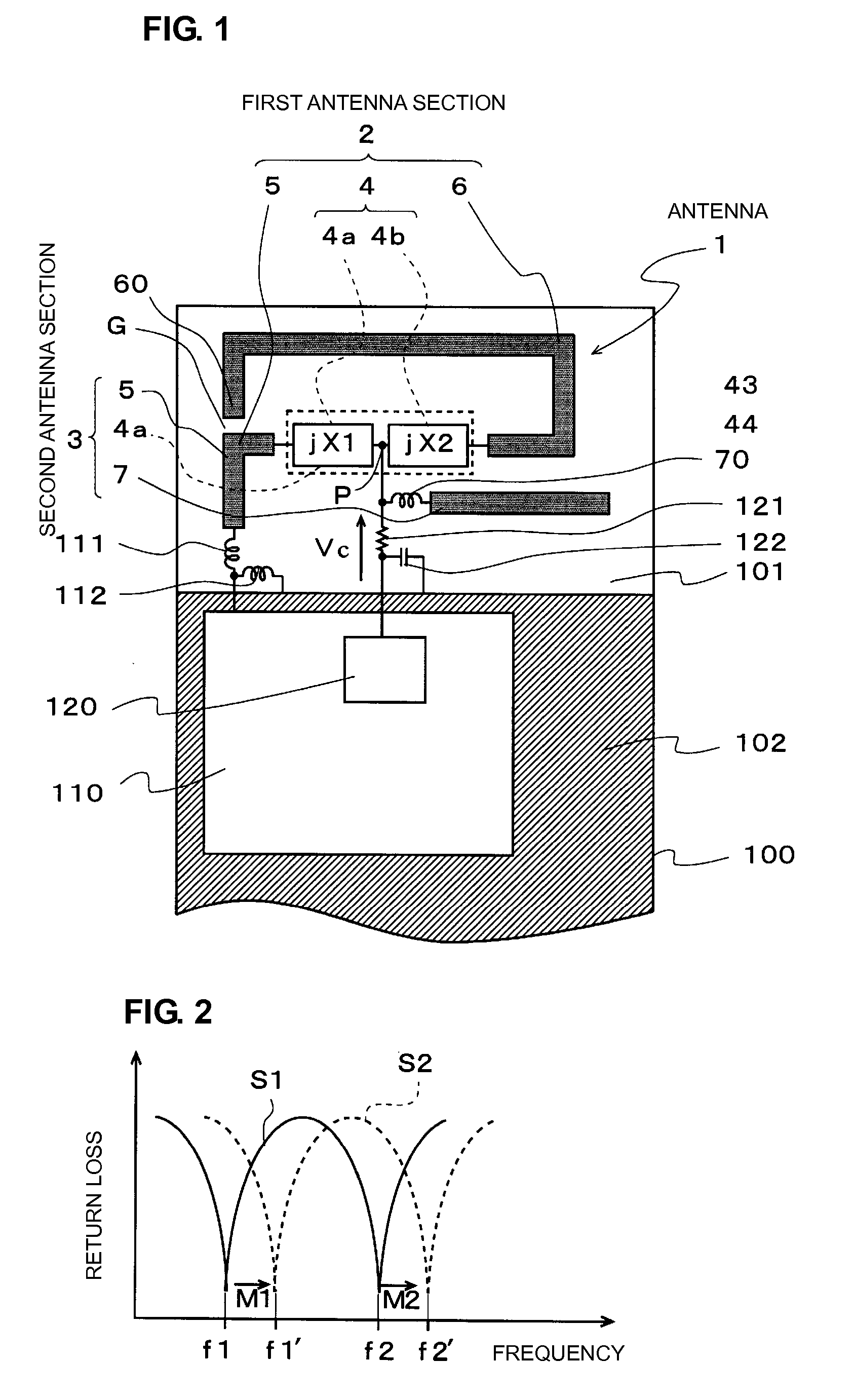Antenna and wireless communication device
a wireless communication and antenna technology, applied in the direction of separate antenna unit combinations, resonant antennas, radiating element structural forms, etc., can solve the problems of not being able to meet the demand for low-voltage operation, not being able to significantly change the third resonant frequency, and not being able to change the resonant frequency. , to achieve the effect of reducing the effect of the resonant frequency of the electrode connected to the series resonance circuit and the small antenna
- Summary
- Abstract
- Description
- Claims
- Application Information
AI Technical Summary
Benefits of technology
Problems solved by technology
Method used
Image
Examples
first preferred embodiment
[0082]FIG. 1 is a schematic plan view showing an antenna according to a first preferred embodiment of the present invention.
[0083] An antenna 1 according to this preferred embodiment is preferably provided on a wireless communication device, such as a cellular phone.
[0084] As shown in FIG. 1, an antenna 1 is provided in a non-ground region 101 of a circuit board 100 of the wireless communication device, and the antenna 1 exchanges high-frequency signals with a transceiver 110 mounted on a ground region 102. Furthermore, a DC control voltage Vc is input to the antenna 1 from a reception-frequency controller 120 provided in the transceiver 110.
[0085] The antenna 1 includes a first antenna section 2 and a second antenna section 3, and the first and second antenna sections 2 and 3 share a frequency-changing circuit 4.
[0086] In the first antenna section 2, a radiating electrode 6 is connected to a feeding electrode 5 via the frequency-changing circuit 4. More specifically, a matching...
second preferred embodiment
[0101]FIG. 4 is a schematic plan view showing an antenna according to a second preferred embodiment of the present invention. FIGS. 5A and 5B are circuit diagrams showing specific examples of the first reactance circuit 4a preferably includes a series circuit, and FIGS. 6A-6D are circuit diagrams showing specific examples of the second reactance circuit 4b of the variable type.
[0102] In an antenna 1 according to this preferred embodiment, specific variable series circuits are used as the first reactance circuit 4a and the second reactance circuit 4b in the first embodiment.
[0103] The first reactance circuit 4a preferably is a series circuit including a variable capacitor or a parallel circuit including a variable capacitor. In this preferred embodiment, a series circuit including a variable capacitor is used. The series circuit including a variable capacitor may be a series circuit shown in part (a) or (b) of FIG. 5. In this example, the series circuit shown in part (a) of FIG. 5 ...
third preferred embodiment
[0108] Next, a third preferred embodiment of the present invention will be described.
[0109]FIG. 7 is a schematic plan view showing an antenna according to the third preferred embodiment of the present invention. FIGS. 8A-8E are circuit diagrams showing specific examples of the second reactance circuit 4b of the fixed type.
[0110] In the second preferred embodiment described above, a series circuit including a variable capacitor is preferably used as the first reactance circuit 4a, and a series circuit including a variable capacitor or a parallel circuit including a variable capacitor is preferably used as the second reactance circuit 4b. In this preferred embodiment, as the second reactance circuit 4b, a series circuit including a fixed capacitor or a parallel circuit including a fixed capacitor is preferably used.
[0111] The series circuit including a fixed capacitor or the parallel circuit including a fixed capacitor may be any of circuits shown in parts (a) to (e) of FIG. 8. In ...
PUM
 Login to View More
Login to View More Abstract
Description
Claims
Application Information
 Login to View More
Login to View More - R&D
- Intellectual Property
- Life Sciences
- Materials
- Tech Scout
- Unparalleled Data Quality
- Higher Quality Content
- 60% Fewer Hallucinations
Browse by: Latest US Patents, China's latest patents, Technical Efficacy Thesaurus, Application Domain, Technology Topic, Popular Technical Reports.
© 2025 PatSnap. All rights reserved.Legal|Privacy policy|Modern Slavery Act Transparency Statement|Sitemap|About US| Contact US: help@patsnap.com



